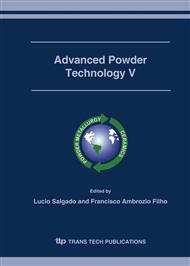p.389
p.395
p.401
p.408
p.414
p.421
p.425
p.432
p.438
Development of ZrO2-TiO2 Porous Ceramic as Soil Humidity Sensor for Application in Environmental Monitoring
Abstract:
Due to the necessity of the automation and control of processes in agriculture, as well as to the crescent interest for the environmental monitoring, efforts have been demanded in the development of more versatile, reliable sensors and sensor systems with smaller cost [1-2]. In this sense, the search of new materials, the modeling study of sensor and the development of new measurement techniques and processing of signs have been orientating the progress in this area [3-4]. In this work, the results of the characterization analyses of sensor elements of ZrO2-TiO2 porous ceramic for application as soil humidity sensor, are shown and discussed. These ceramics were obtained from the mechanical mixture of ZrO2- TiO2 powders and sintered at 1000, 1100 and 1200 oC, for obtaining different porosities. The characterization of the ceramic was carried out using measurements of B.E.T.; nitrogen and mercury porosimetry; scanning electronic microscopy and X-ray diffraction. The porous ceramic characterization as soil humidity sensor element was accomplished through capacitance and impedance measurements using a RLC bridge. The ceramic sensor elements were immersed in the selected and previously characterized soils, the humidities of which were defined in accordance with Atterberg limits, more exactly liquid limit. The results obtained for specific surface area, distribution curves of pore size, microstructure, crystalline phases and sensibility to the soil humidity showed that the ZrO2-TiO2 porous ceramic sintered at 1100 oC presents a great potential to be applied as sensor element for soil humidity monitoring.
Info:
Periodical:
Pages:
414-419
Citation:
Online since:
November 2006
Price:
Сopyright:
© 2006 Trans Tech Publications Ltd. All Rights Reserved
Share:
Citation:


